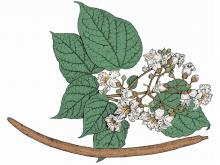Trees, Shrubs and Woody Vines
Media

Species Types
Scientific Name
Juniperus virginiana
Description
By far the most common native conifer in the state, eastern red cedar is useful for its aromatic, red wood and beloved for its greenery, its resinous blue “berries,” and the spicy odor it lends the outdoors.
Media

Species Types
Scientific Name
Lonicera maackii (Amur) and Lonicera x bella (bella)
Description
If there’s a giant green thicket in your woods, you may have a bush honeysuckle infestation. These invasive plants are shrubby natives of Asia. In America, where they have no natural controls, they leaf out early, grow fast, spread fast, and form dense thickets that crowd out native forest plants.
Media

Species Types
Scientific Name
Acer rubrum
Description
Red maple is one of our most useful — and beautiful — native trees. You can find it in the woods as well as in landscape plantings statewide. Many horticultural varieties are available at nurseries.
Media

Species Types
Scientific Name
Acer negundo
Description
A member of the maple family, box elder is often confused with poison ivy because its compound leaves sometimes grow in threes (though also in fives). A fast-growing tree, its winged seeds betray its relationship to other maples.
Media

Species Types
Scientific Name
Salix spp. (about 12 species in Missouri)
Description
Exotic willows are available at lawn and garden centers, but there are several willow species that are native to Missouri. Most are rather humble colonizers of gravel bars, riverbanks, and lakesides. Many are important for human economic interests. All have a place in our wild ecosystems.
Media

Species Types
Scientific Name
Lonicera japonica
Description
Don’t kid yourself about this invasive, exotic vine: Japanese honeysuckle is an aggressive colonizer that shades out native plants and harms natural communities. Learn how to recognize it!
Media

Species Types
Scientific Name
Euonymus fortunei
Description
Introduced from Asia as a groundcover, wintercreeper has escaped cultivation in all the eastern states. It’s frequently found near urban centers, with heavy infestations in woodlands around St. Louis and Kansas City.
Media

Species Types
Scientific Name
Cornus amomum
Description
Swamp dogwood, or silky dogwood, grows nearly statewide in wet locations. Recognize it by its reddish-brown or dark brown young branchlets and blue, berrylike fruit, conspicuous in late fall.
Media

Species Types
Scientific Name
Cornus spp.
Description
Missouri’s five species of dogwoods are shrubs or small trees with distinctive flowers, fruits, and bark. The fruits may be red, white, or blue. The leaves have characteristic arching veins.
Media

Species Types
Scientific Name
Catalpa speciosa
Description
Of the three species of catalpas in our state, northern catalpa is the only one native to Missouri (specifically, the Bootheel region). It has been planted widely, though, and has naturalized in many places. A popular ornamental and shade tree with pretty, orchidlike flowers and long, beanlike fruit.
See Also
About Trees, Shrubs and Woody Vines in Missouri
There are no sharp dividing lines between trees, shrubs, and woody vines, or even between woody and nonwoody plants. “Wood” is a type of tissue made of cellulose and lignin that many plants develop as they mature — whether they are “woody” or not. Trees are woody plants over 13 feet tall with a single trunk. Shrubs are less than 13 feet tall, with multiple stems. Vines require support or else sprawl over the ground.





















